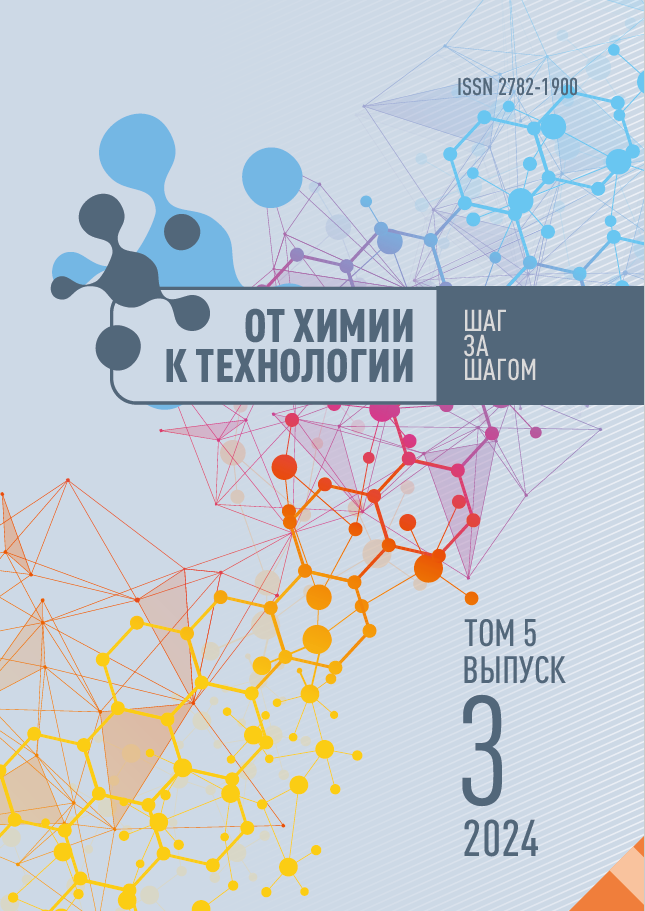Ivanovo, Ivanovo, Russian Federation
Ivanovo, Ivanovo, Russian Federation
The purpose of this study is to develop a modified sorbent of flax waste and investigate its sorption properties towards Cu (II) ions. The authors conducted the modification in two steps. The first step was oxidation of flax fibre cellulose with sodium metaperiodate to dialdehyde cellulose, the second one was the addition of taurine to increase the sorption characteristics of the modified sorbent. The paper presents the conditions for the periodate oxidation reaction of flax fibre and the treatment of the resulting dialdehyde cellulose with taurine. We determined the sorption characteristics of the modified sorbent in comparison with the original flax fibre. Kinetic studies allowed us to establish the time of reaching sorption equilibrium in the heterophase system ‘aqueous solution of metal salt-sorbent’ and determine the reaction order using pseudo first and pseudo-second order kinetics models. The authors processed the sorption isotherms obtained during the experiments using the Langmuir model. The maximum sorption capacity increased by 3 times compared to the original flax fibre. IR spectroscopy confirmed the improvement of equilibrium and kinetic characteristics of flax fibre occuring as a result of the appearance of new sorption centres in its structure.
flax fibre, copper ions, taurine, sorption, modification
1. Vardhan K.H., Kumar P.S., Panda R.C. A review on heavy metal pollution, toxicity and remedial measures: current trends and future perspectives // Journal of Molecular Liquids. 2019. No. 290. Pp. 111-197.
2. Lindholm-Lehto P. Biosorption of heavy metals by lignocellulosic biomass and chemical analysis // Bio Resources. 2019. No. 14. Pp. 4952-4995.
3. Yadav S., Yadav A., Bagotia N., Sharma A.K., Kumar S. Adsorptive potential of modified plant-based adsorbents for sequestration of dyes and heavy metals from wastewater - A review // Journal of Water Process Engineering. 2021. No. 42. Pp. 102-148.
4. Dawn S.S, Vishwakarma V. Recovery and recycle of wastewater contaminated with heavy metals using adsorbents incorporated from waste resources and nanomaterials - A review // Chemosphere. 2021. Vol. 273. 129677. DOI: https://doi.org/10.1016/j.chemosphere. 2021.129677.
5. Gordina N.E., Prokof’ev V.Y., Hmylova O.E., Kul’pina Y.N. Effect of ultrasound on the thermal behavior of the mixtures for the LTA zeolite synthesis based on metakaolin // Journal of Thermal Analysis and Calorimetry. 2017. Vol. 129, no. 3. P. 1415-1427.
6. Tursi A. A review on biomass: importance, chemistry, classification and conversion // Biofuel Research. 2019. No. 6. Pp. 962-979.
7. Nikiforova T.E., Kozlov V.A., Vokurova D.A., Ivanov S.N. Vliyanie modificirovaniya l'nyanogo volokna polietilenpoliaminom na sorbciyu ionov Cu(II) i Cd(II) [Effect of modification of flax fibre polyethylene polyamine on the sorption of ions Cu(II) and Cd(II)] // Rossijskij himicheskij zhurnal (Zhurnal Rossijskogo himicheskogo obshchestva) [Russian Chemical Journal (Journal of the Russian Chemical Society)]. 2023. Vol. LXVII. No. 3. P. 63-72. DOI:https://doi.org/10.6060/RCJ.2023673.9. (In Russian).
8. Meretin R.N., Nikiforova T.E. Issledovanie reakcionnoj sposobnosti poverhnosti uglerodsoderzhashchego silikatnogo sorbenta rastitel'nogo proiskhozhdeniya [Investigation of the reactivity of the surface of carbon-containing silicate sorbent of plant origin] // Izv. vuzov. Himiya i him. tekhnologiya [Proceedings of universities. Chemistry and chemical technology]. 2021. Vol. 64. Iss. 11. Pp. 147-155. DOI:https://doi.org/10.6060/ivkkt.20216411.6408 (In Russian).
9. Thakur V., Sharma E., Guleria A., Sangar S., Singh K. Modification and management of lignocellulosic waste as an ecofriendly biosorbent for the application of heavy metal ions sorption // Materials Today: Proceedings. 2020. V. 32. Part 4. Pp. 608-619, DOI:https://doi.org/10.1016/j.matpr.2020.02.756.
10. Nikiforova T.E., Vokurova D.A., Sofronov A.R. Extraction of copper ions by a sorbent based on flax fiber modified with L-arginine // From Chemistry Towards Technology Step-by-Step. 2022. Vol. 3, Iss. 3. Pp. 17-26. URL: https://chemintech.ru/ru/nauka/issue/5031/view DOI:https://doi.org/10.52957/27821900_2022_03_17 (accessed 08.06.2024) (in Russian).
11. Kajeiou M., Alem A., Mezghich S., Ahfir N.-D., Mignot M., Devouge-Boyer C., Pantet A. Competitive and non-competitive zinc, copper and lead biosorption from aqueous solutions onto flax fibers // Chemosphere. 2020. No. 260. Pp. 127-505.
12. Dey P., Mahapatra B.S., Juyal V.K., Pramanick B., Negi M.S., Paul J., Singh S.P. Flax processing waste – A low-cost, potential bio sorbent for treatment of heavy metal, dye and organic matter contaminated industrial wastewater // Industrial Crops & Products. 2021. No. 174. Pp. 114-195.
13. Razak M.R., Yusof N.A., Aris A.Z., Nasir H.M., Haron Md.J., Ibrahim N.A., Johari I.S., Kamaruzaman S. Phosphoric acid modified kenaf fiber (K-PA) as green adsorbent for the removal of copper (II) ions towards industrial waste water effluents // Reactive and Functional Polymers. 2020. V. 147. DOI:https://doi.org/10.1016/j.reactfunctpolym.2019.104466.
14. Liu Y., Qiao L., Wang A., Li Y., Zhao L., Du K. Tentacle-type poly(hydroxamic acid)-modified macroporous cellulose beads: Synthesis, characterization, and application for heavy metal ions adsorption // Journal of Chromatography A. 2021. V. 1645. Pp. 462098. DOI:https://doi.org/10.1016/j.chroma.2021.462098.
15. Hussain D., Khan S.A., Alharthi S.S., Khan T.A. Insight into the performance of novel kaolinite-cellulose/cobalt oxide nanocomposite as green adsorbent for liquid phase abatement of heavy metal ions: Modelling and mechanism // Arabian Journal of Chemistry. 2022. V. 15. No. 7. P. 103925. DOI:https://doi.org/10.1016/j.arabjc.2022.103925.
16. Krichevskiy G.E. Chemical technology of textile materials: textbook for universities in 3 volumes. Vol. 1. Theoretical bases of technology. Fibres. Contaminants. Preparation of textile materials. - M. : RosZITLP, 2000. - 436 p. (In Russian).
17. Yoshinari N., Kuwamura N., Kojima T., Konno T. Development of coordination chemistry with thiol containing amino acids // Coordination Chemistry Reviews. 2023. V. 474. P. 214857. DOI:https://doi.org/10.1016/j.ccr.2022.214857.
18. Vasiliev V.P. Analytical chemistry. In 2 volumes. Vol. 2. Physico-chemical methods of analysis: textbook for chemical-technological specialities of higher educational institutions. 6th ed. - Moscow: Higher School, 2004. - 383 p. (In Russian).
19. Kokotov Yu.A., Pasechnik V.A. Equilibrium and kinetics of ion exchange. L.: Khimiya, 1970. 336 p. (in Russian).
20. Ahnazarova S.L., Kafarov V.V. Methods of experiment optimisation in chemical technology. Moscow: Vysshaya Shkola, 1985. 327 p. (in Russian).
21. Tarasevich B.N. IR spectra of the main classes of organic compounds // Reference materials. Lomonosov Moscow State University. Moscow, 2012. - 55 p. (In Russian).







